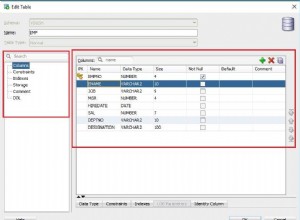To pytanie jest dla mnie bardzo mylące. Jeśli prawdziwe pytanie brzmi, jak obliczyć kwartał arbitralnej DATE to jest już mnóstwo przykładów, takich jak:
Jak obliczyć kwartał arbitralnej daty
Niektóre daty testów:
create table lots_of_dates as
select trunc(sysdate - level * 7) as d
from dual
connect by level <= 52;
Znajdź kwatery:
select d,
to_char(d, 'YYYY-Q') as QUARTER,
trunc(d, 'Q') as Q_FIRST_DAY,
add_months(trunc(d, 'Q'), 3) - 1 as Q_LAST_DAY
from lots_of_dates
order by 1;
Wyniki:
D QUARTE Q_FIRST_DAY Q_LAST_DAY
------------------ ------ ------------------ ------------------
02-SEP-12 2012-3 01-JUL-12 30-SEP-12
09-SEP-12 2012-3 01-JUL-12 30-SEP-12
16-SEP-12 2012-3 01-JUL-12 30-SEP-12
23-SEP-12 2012-3 01-JUL-12 30-SEP-12
30-SEP-12 2012-3 01-JUL-12 30-SEP-12
07-OCT-12 2012-4 01-OCT-12 31-DEC-12
14-OCT-12 2012-4 01-OCT-12 31-DEC-12
21-OCT-12 2012-4 01-OCT-12 31-DEC-12
28-OCT-12 2012-4 01-OCT-12 31-DEC-12
04-NOV-12 2012-4 01-OCT-12 31-DEC-12
11-NOV-12 2012-4 01-OCT-12 31-DEC-12
...
Procedura PL/SQL, która zwraca pierwszy i ostatni dzień kwartału
Daty rozpoczęcia i zakończenia kwartału są stałe dla wszystkich lat z wyjątkiem części roku. Tj. drugi kwartał rozpoczyna się zawsze 1 kwietnia i kończy się 30 czerwca każdego roku. W ten sposób można ustalić dzień i miesiąc, a tylko część roku należy dostosować.
Funkcja może zwrócić tylko jedną wartość, więc podprogram jest zaimplementowany jako procedura. Do procedury dodałem również wrappery funkcji:
-- raises CASE_NOT_FOUND for non-existing quarters
create or replace procedure get_quarter_days(
p_year in number,
p_quarter in number,
p_first_day out date,
p_last_day out date
) deterministic as
begin
case p_quarter
when 1 then
p_first_day := to_date(p_year || '-01-01', 'YYYY-MM-DD');
p_last_day := to_date(p_year || '-03-31', 'YYYY-MM-DD');
when 2 then
p_first_day := to_date(p_year || '-04-01', 'YYYY-MM-DD');
p_last_day := to_date(p_year || '-06-30', 'YYYY-MM-DD');
when 3 then
p_first_day := to_date(p_year || '-07-01', 'YYYY-MM-DD');
p_last_day := to_date(p_year || '-09-30', 'YYYY-MM-DD');
when 4 then
p_first_day := to_date(p_year || '-10-01', 'YYYY-MM-DD');
p_last_day := to_date(p_year || '-12-31', 'YYYY-MM-DD');
end case;
end;
/
show errors
create or replace function get_quarter_first_day(
p_year in number,
p_quarter in number
) return date deterministic as
v_first_day date;
v_last_day date;
begin
get_quarter_days(p_year, p_quarter, v_first_day, v_last_day);
return v_first_day;
end;
/
show errors
create or replace function get_quarter_last_day(
p_year in number,
p_quarter in number
) return date deterministic as
v_first_day date;
v_last_day date;
begin
get_quarter_days(p_year, p_quarter, v_first_day, v_last_day);
return v_last_day;
end;
/
show errors
Jak korzystać z powyższych podprogramów:
declare
v_first_day date;
v_last_day date;
begin
get_quarter_days(2011, 1, v_first_day, v_last_day);
dbms_output.put_line(v_first_day || ' - ' || v_last_day);
get_quarter_days(2012, 2, v_first_day, v_last_day);
dbms_output.put_line(v_first_day || ' - ' || v_last_day);
get_quarter_days(2013, 3, v_first_day, v_last_day);
dbms_output.put_line(v_first_day || ' - ' || v_last_day);
get_quarter_days(2014, 4, v_first_day, v_last_day);
dbms_output.put_line(v_first_day || ' - ' || v_last_day);
dbms_output.put_line(get_quarter_first_day(2015, 1) || ' - ' ||
get_quarter_last_day(2015, 1));
end;
/




